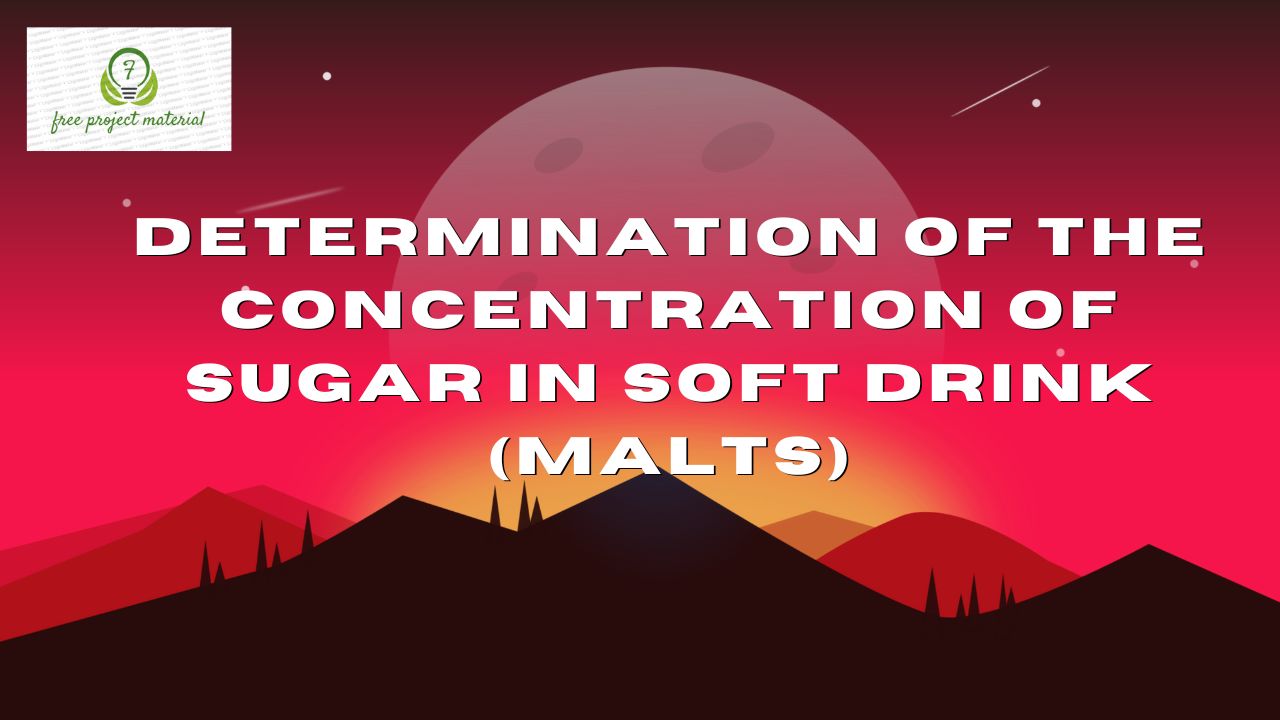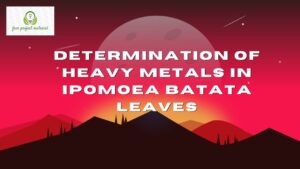ABSTRACTS
The determination of sugar concentration in the soft drinks was carried out. The five drinks were labeled S1, S2, S3, S4 and S5 respectively. The soft drinks were analyzed using densitometer and refractometer. The result show that S1 and S4 have the higher percentage of sugar content of 14.092% and 14.052%, while S2 has the least percentage of sugar. It also shows that all the brand of soft drinks tested contained sucrose as the only sugar present and that the sugar level as well as the densities varied through the brands S1>S4>S5>S3>S2. The observed values were within the acceptable limits.
TABLE OF CONTENTS
TITLE PAGE – – – – – – – – i
CERTIFICATION – – – – – – – ii
DEDICATION – – – – – – – – iii
ACKNOWLEDGEMENTS – – – – – – iv
ABSTRACT – – – – – – – – v
TABLE OF CONTENTS – – – – – – – vi-ix
CHAPTER ONE
1.0 Background of the Study – – – – – 1-6
1.1 Aim and Objectives of the Study – – – – 6
1.2 Significance of the Study – – – – – 6-7
1.3 Scope and Limitation of the Study – – – – 7
CHAPTER TWO
2.0 LITERATURE REVIEW
2.1 Overview of Sugar – – – – – – 8-10
2.2 Modern History of Sugar – – – – – 10-13
2.3 Chemistry of Sugar – – – – – – 14-15
2.3.1 Natural Polymer – – – – – – – 15-16
2.3.2 Flammability and Heat Response – – – – 16-17
2.4 Types of Sugar – – – – – – – 17
2.4.1 Monosaccharide – – – – – – – 17-19
2.4.2 Disaccharides – – – – – – – 19-21
2.5 Sources of Sugar – – – – – – – 21-22
2.6 Production of Sugar – – – – – – 23
2.6.1 Sugar Beet – – – – – – – – 23-24
2.6.2 Sugar Cane – – – – – – – – 24-25
2.6.3 Refining – – – – – – – – 25-27
2.7 Forms and Uses of Sugar – – – – – – 27-31
2.8 Health Effects of Sugar Consumption – – – – 31-35
2.9 Review of Sugar Content in Common Soft Drinks – – 35
CHAPTER THREE
3.0 MATERIALS AND METHOD
3.1 Materials – – – – – – – – 36
3.2 Methods – – – – – – – – 37
3.2.1 Sample Collection – – – – – – 37
3.2.2 Sample Preparation – – – – – – 37
3.3 Sample Analysis – – – – – – – 38
CHAPTER FOUR
4.0 RESULT AND DISCUSSION
4.1 Result – – – – – – – – 39-40
4.2 Discussion – – – – – – – – 40-41
CHAPTER FIVE
5.0 CONCLUSION, RECOMMENDATION AND SUGGESTION FOR FURTHER STUDIES
5.1 Conclusion – – – – – – – – 42
5.2 Recommendation – – – – – – – 43
5.3 Suggestion for Further Studies – – – – – 43
Appendix
References
CHAPTER ONE
INTRODUCTION
1.1 Background of the study
Sugar is a white crystalline carbohydrate used as a sweetener and preservative. Sugars are used extensively in food industries and at home as a sweetener and as a source of energy particularly in non-alcoholic beverage. Sugars are the most abundant and widely distributed food component in the form of carbohydrate (Agbazua et al., 2014)
Carbohydrates provide most of the energy in almost all human diets. In the diets of poor people, especially in the tropics, up to 90 percent of the energy may come from this source. On the other hand, in the diets of the rich in many countries the figure may be as low as 40 percent (40%).
Green plants can synthesize carbohydrates from water and carbon dioxde under the influence of sunlight; a process known as photosynthesis. The major product of photosynthesis is the six-carbon sugar, D-glucose
6H2O + 6CO2 C6H12O6 + 6O2(g)
All carbohydrates are made up of units of sugar (also called saccharide units). Carbohydrates that contain only one sugar unit (monosaccharides) or two sugar units (disaccharides) are referred to as simple sugars. Simple sugars are sweet in taste and are broken down quickly in the body to release energy (Agbazua et al., 2014).
The three major groups of sugar are monosaccharaides, oligosaccharides and polysaccharides.
Monosaccharides are the simplest forms of sugar and cannot be broken down any further by hydrolysis. They contain from 3-6 atoms of carbon in each molecule. They include trioses, tetroses, pentoses and hexoses, according to whether they contain 3, 4, 5 or 6 carbon atoms respectively. Only the hexoses occur in appreciable amount in human foods. Below are examples of hexoses with their structures.
Oligosaccharides are relatively low molecular weight sugars, which contain from 2-10 monosaccharides joined by glucosedic likages. They include the disaccharides, trisaccharides, tetrasaccharides, etc.
These are colloidal molecules of many molecules of monosaccharides. They are the most complex and the least sweet. They have high relative molecular mass corresponding to a general molecular formula, (C6H10O5)n. They include cellulose and starch
Sugar (especially sucrose) can be obtained from natural sources such as sugar cane, beet sugar, honey, etc. It is difficult to determine when sugar (saccharim officinarum) first became known to mankind, but there is an indication that it came from New Guinea to India many centuries before Christ. Today, table sugar (sucrose) is obtained commercially from only two plants, sugar cane and beet sugar, which provide 56% and 44%, respectively of the world’s total.
Methods for extracting and purifying the sugar from the cane or beet were slow in being developed. Use of granular activated carbon and ion exchange processes to remove colour has become common. Evaporation, adsorption, centrifugation, filtration, crystallization and affination were from the beginning the important steps in the manufacturing sequence. Much of our knowledge of these methods came from their applications in the sugar industries.
A soft drink is a beverage that does not contain alcohol. The term “soft drink” originally referred exclusively to carbonated drinks, and is still commonly used in this manner. The name “soft drink” specifies lack of alcohol by way of contrast to the term “hard” (i.e. drinks with alcoholic content). Many carbonated soft drinks are optionally available in versions sweetened with sugar or with low caloric sweeteners8-9. ln Nigeria Standards Organization of Nigeria (SON) sets the standards for regulating the quantity of sugar and other ingredients in soft drinks.
Soft drinks are heavily consumed mainly because of their nutritional value, as companies promote them vigorously and market them everywhere. Their sweetness endears them to lovers of sweet foods, especially for their ability to give quick energy owing to their high calorific content.
Sugar, one of the major contents of soft drinks is a paradox. In as much as it plays vital roles in food technology and medicine, it is also toxic to the body when it is above normal levels in human blood (4.5-5.5 g/dm3). High blood sugar levels have been found to promote heart failure and stroke. High sugar levels can poison the body and destroy the organs unless kept in check by an agent called insulin. Health problems caused by high sugar intake include: diabetes, hypoglycemia, dental caries and obesity.
To be able to watch the sugar level in one’s blood for healthy living, it is helpful to know the low and high sugar foods items.
This work therefore, focuses on assessing the sugar level in some commonly consumed soft drinks (Malts):
- Guiness malt
- Grand malt
- Amstel malt
- Maltina
- Malt
1.2 Aim and Objectives of the Study
The aim of this study is to determine the sugar content in soft drink (Grand malt, Guiness malt, Amstel malt, Maltina, D. malt) using Refractometry method.
The specific objectives of this study is to: Estimate the level of sugar in Guiness malt, Grand malt, Amstel malt, Maltina, Dubic malt.
- To compare the level of the sugar content in each of these soft drink.
- To compare the sugar contents of these soft drinks with permissible sugar level in beverages and soft
Drink.
- To make useful recommendations based on the findings.
1.3 Significance of the Study
The significance of the study are as follows:
- It will help to create awareness to students on the level of sugar contents in the soft drinks.
- It will serve as a source of information to the future researchers on this topic or related field.
- It will also alert the government to take appropriate measures to control sugar content in soft drinks.
1.4 Scope and Limitations
This research only covers the determination of sugar content in soft drinks (Grand malt, Guiness malt, Amstel malt, maltina, Dubic malt). The following limitations were encountered during the course of the study.
- Financial constraint
- Time constraint
- Inadequate or poor power supply
- Lack of some apparatus for analysis



